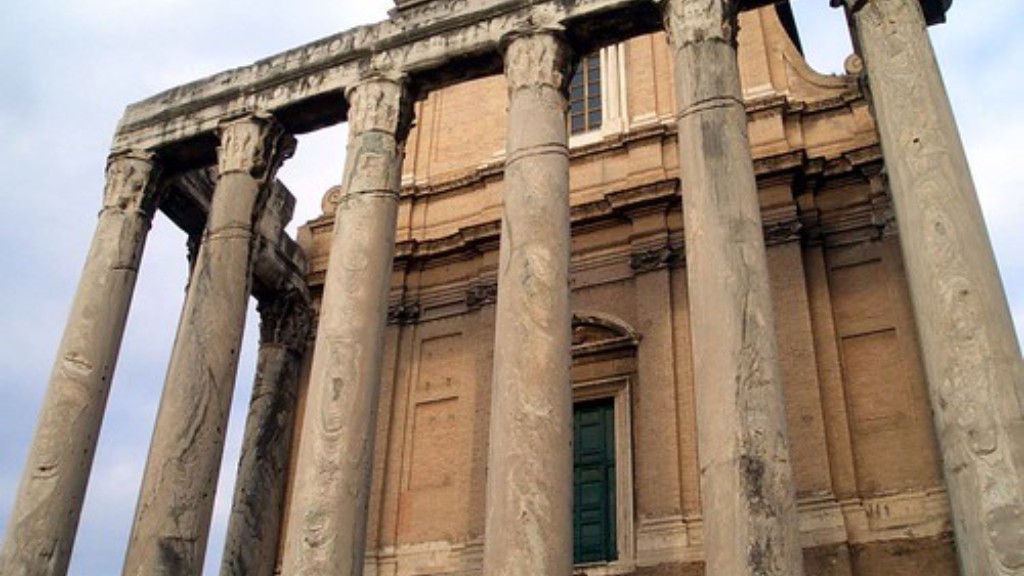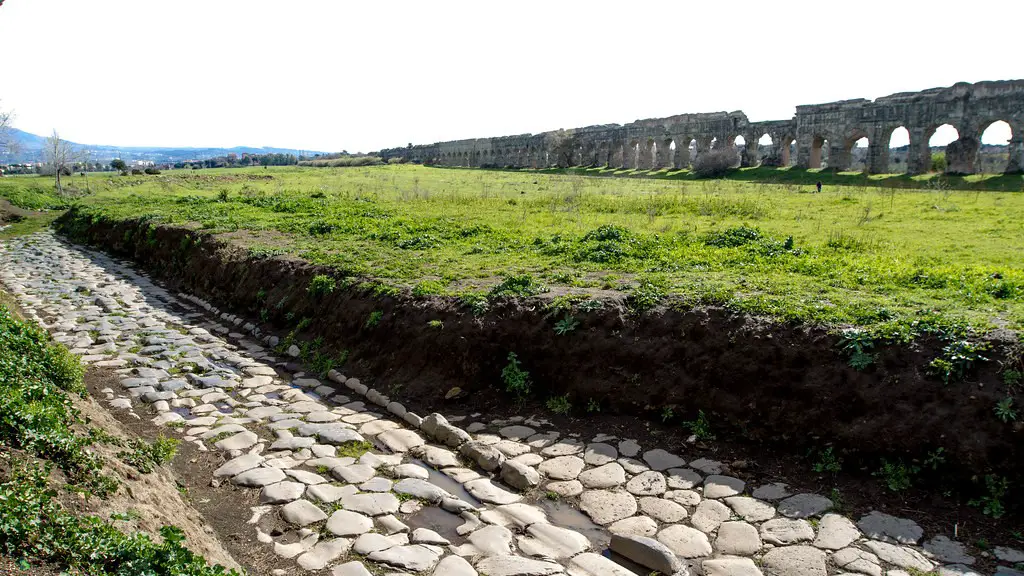The almost eternal appeal of the Roman culture has made its way down to us. Just like the other aspects of their culture, their beds have also captivated our attention. In this article,we will explore the different types of beds that were made and used by the ancient Romans.
The most widely used bed-type in Rome was the lectus, which featured a wooden frame with a variable number of mattresses, pillows and blankets made from wool or linen. Some bed-frames would include a footboard, while others had a rope-by-rope system which enabled the bed’s occupant to make the mattress higher or lower as desired. This rope-by-rope system also created even support for the mattress and prevented sagging.
According to historians, some Roman beds had intricate designs and decorations. These bed types were entitled lectus tricliniarus. They were supposedly covered in jewels and gold ornaments and featured intricate carvings. These luxurious pieces of furniture would also have cushions and a frame to support the occupant.
Even during the Roman times, bed shapes and sizes varied from family to family. The wealthy citizens of Rome had access to opulent beds that were often made in the shape of a boat or a curving outline. These allowed the inhabitants to recline full-length while they rested.
In addition to the luxurious beds, Roman homes also displayed lectus discubitus. These were common sleeping benches made of wood with two sides and a backrest, allowing two people to sit side-by-side and rest comfortably.
The Romans also used lectus cubicularis. This bed-type was exclusive to the bedrooms of the wealthy. They featured high wooden frames that could either be draped in fabric or topped with wooden canopies.
The ancient Romans also used sleeping crevices for beds.These crevices were dug near the windows of Roman houses and lined with mattresses and linen. The morning sunlight was their only source of heat.
Daybeds
In addition to the usual sleeping beds, the Romans also made use of lectus diurnalis, or daybeds. These were single beds that were used for resting during the day. They featured low wooden beds, complete with one or more mattresses and pillows.
Daybeds were usually placed in living areas and occupied by the ancient Romans either alone or when they had visitors. They could also be used while playing backgammon, gaming or reading.
The daybeds were usually covered with cushions to make sitting and resting more comfortable. Some of them would be made in the shape of a crescent, with two distinct pieces that would be brought together to form a single piece of furniture.
In some cases, the daybeds were made wider than the usual sleeping beds and featured higher headboards that would act as arms for the occupants. They featured fabric cushions and pillows and became the perfect venue for conversations and meetings.
Bedding
Finally, no bed in ancient Rome was complete without the bedding. The most used component of the bedding was wool, which was used to make blankets and pillows. Linen was also popular, especially among the wealthy Romans who could afford it.
The mattresses were filled with a combination of straw, wool, bellus or down, depending on the wealth of the family. The mattresses would be placed over the bed frame and then covered with blankets and pillows. When not in use, these would also be removed and stored away until needed.
Apart from the bed-types, bedding was also used to provide extra warmth and comfort during the winter months. These included fur rugs either made of the finest bear- or sheep-fur or simple fleece.
In conclusion, the ancient Romans did not have the most opulent beds but were surely creative and ingenious in what they created and how they used them. Therefore, we can assume that they enjoyed their beds just like us today.
Living Spaces
The type of bed used by the Romans would depend on the room in which it was placed. The wealthier families would have intricately designed and decorated beds in their bedrooms, while the less affluent would have smaller beds with less luxurious decorations. Some of the more affluent families would also have separate living and sleeping areas, while the less privileged would have to use a single bedroom for both.
In many cases, the living area beds would be more intricately designed, sometimes featuring gold, silver or bronze trim. The beds would also be draped in fabric or have a wooden canopy overhead.
Of course, not all the beds in an ancient Roman home were huge and luxurious. The Roman fold-away bed was a popular choice for small and cramped quarters. This bed was made of iron and could be quickly folded up and stored away when not in use.
The most important thing to keep in mind is that in ancient Rome, beds were a form of luxury and comfort. Whether they were big or small, they were usually a symbol of wealth and status and offered the occupants memorable moments of relaxation.
Hygiene and Health
Due to their limited access to the modern amenities we enjoy today, the Romans had to rely on other methods to keep their beds clean. The Romans believed in cleanliness and would regularly air out their beds and mattresses, while also using tools to get rid of bed bugs.
The bed was also important from a medical point of view. Ancient medical texts would often recommend that the patient lay in bed as a form of treatment. Therefore, the comfort and design of the bed could have a direct impact on a Roman’s health.
In some cases,Roman physicians would recommend certain types of beds for ailing patients. These beds featured special features that would facilitate the patient’s recovery. For instance, some bed frames would be higher on one side than the other, and the patient would be expected to sleep in that particular position.
Other types of beds that were recommended included beds with a headrest and an adjustable bed frame. In this way, the patient would be able to adjust the mattress and make it more comfortable.
Woodwork
Woodworking was a well-known craft in the Roman Empire. Artisans had access to different types of wood and they managed to transform that wood into comfortable and luxurious beds. These beds featured elaborate designs, were often decorated with jewels, gold and silver and featured intricate carvings.
These beds were extremely expensive and only the wealthiest citizens of Rome had access to them. Therefore, the bed was regarded as a symbol of wealth and power in the Roman Empire.
In conclusion, beds made out of wood were a valuable asset to the Romans and a mark of their wealth and power. Their creations can still be found in museums and other historical places.
Mattresses and Pillows
The Romans used a variety of materials for their mattresses and pillows, including straw, wool and bellus. The mattresses were filled with a combination of these materials and covered with blankets and pillows. The pillows were filled with wool, feathers, down or a combination of these materials.
The Romans were also known to use bed warmers. These were small bronze containers that were filled with hot coals and placed under the bed at night. This would ensure that the bed was kept warm, even during the cold winter months.
The Romans were also known to use wooden planks or boards for their beds, tightening the ropes to support the mattress. This helped to keep the mattress from sagging and prevented the occupants from rolling off the bed.
In addition to mattresses and pillows, the Roman beds would also be adorned with other items, such as rugs and fur covers. These were used not only to provide warmth but also to keep the bed clean and comfortable.
Roman Geography
The type of bed used by the Romans depended on the geographical region in which they lived. In colder regions, fur rugs and thicker blankets would be used to keep the occupant warm. In warmer areas, the beds would be simpler, with fewer blankets and cushions.
In addition, the different regions of the Roman Empire would also feature different bed designs. In cities like Rome, the beds would be more intricate and feature elaborate decorations. In rural areas, the beds would be simpler and made from more basic materials.
Therefore, beds in ancient Rome were not just a symbol of wealth and power, but also a reflection of the geographical region in which they were made.
Social Implications
The bed types chosen by an ancient Roman citizen had distinct social implications. In Roman culture, a bed was more than just a form of comfort and relaxation. It was also a status symbol and a marker of wealth and power.
The wealthier families had access to bigger and more elaborate beds, while the less affluent would have smaller and simpler ones. This also applied to the type of bedding used.
The Roman bed was also a symbol of family values, since it was often used as the venue for family conversations and meetings. In this sense, it was more than just a form of comfort but also a place for bonding and strengthening familial ties.
Finally, the bed was also a place for relaxation and entertainment. Wealthier families would have sleepovers or dinners in the bedroom, featuring food, wine and entertainment.
To sum up, the bed was very important in Roman culture and had both practical and social implications.





